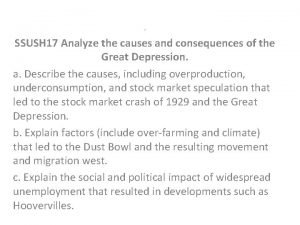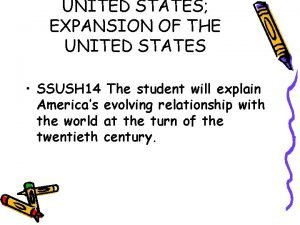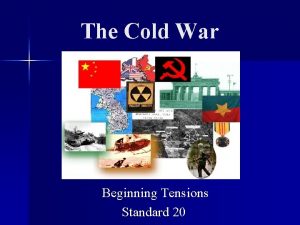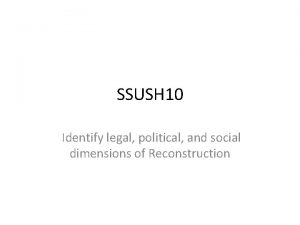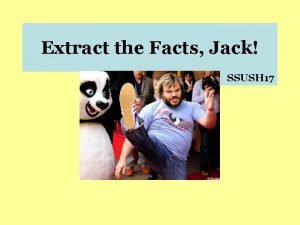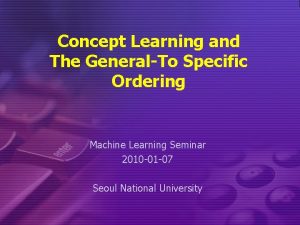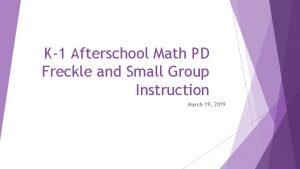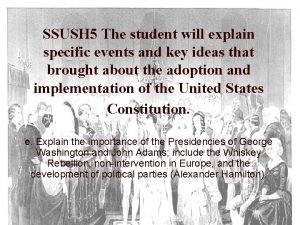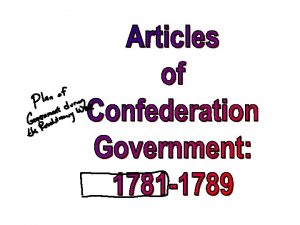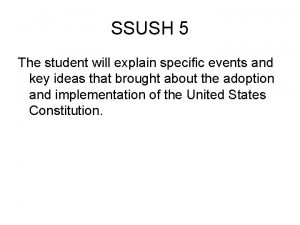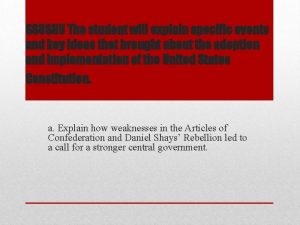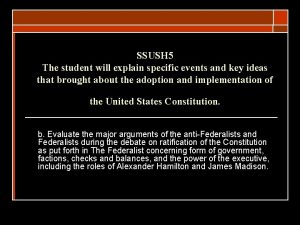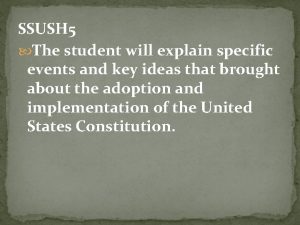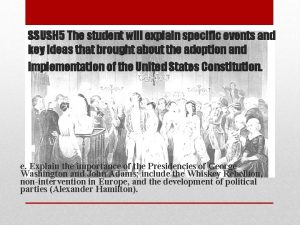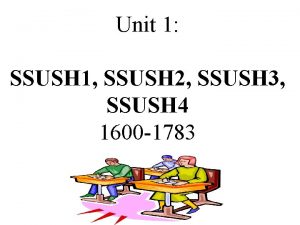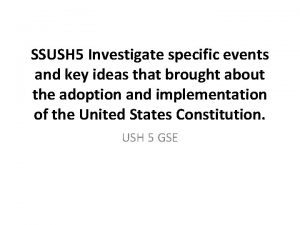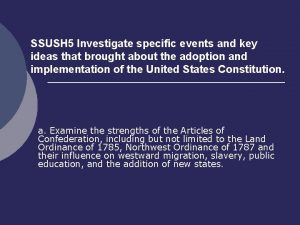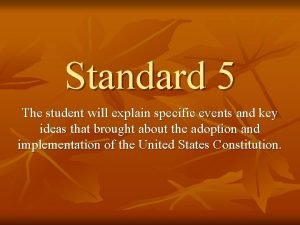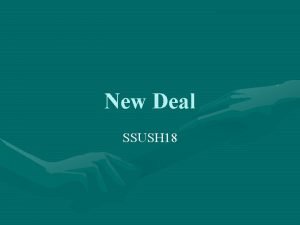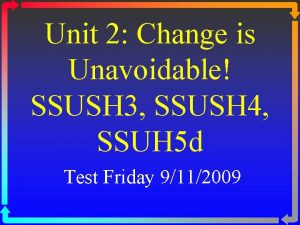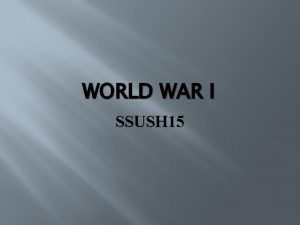SSUSH 5 The student will explain specific events









































- Slides: 41


SSUSH 5 The student will explain specific events and key ideas that brought about the adoption and implementation of the United States Constitution • a. Explain how weaknesses in the Articles of Confederation and Daniel Shays’ Rebellion led to a call for a stronger central government.

• • Articles of Confederation The first Constitution of the United States. It was weak because it lacked provisions for executive and judicial powers. It reflected the Americans‘ fear of a powerful national government. As a result, it created a government that had no power to tax, regulate commerce (trade), establish one national currency.

Articles of Confederation • The Articles gave individual states more power than the national government had. • As a result, conflicts between the states threatened the existence of the nation.


Shays Daniel Shay 1784 to 1785, unfair taxes, debt and foreclosure Farmer’s rebellion to overthrow Mass. Govt.

Shays’ Rebellion • An attempt by a group of indebted farmers to secure weapons from a Federal Armory, • became the catalyst for the United States to recognize the need for a new constitution. • Without the ability to tax, the central government could not repair the national economy

Shay’s Rebellion • Led by a former officer in the Continental Army, this rebellion of Massachusetts farmers was caused by the state‘s decision to increase taxes rather than print paper money, which in turn caused bankruptcy for many farmers. After marching on the state capitol, the farmers fought the state militia, and were eventually put down.

Shays’ Rebellion: 1786 -7 There could be no stronger evidence of the want of energy in our governments than these disorders. -- George Washington

• Evaluate the major arguments of the anti. Federalists and Federalists during the debate on ratification of the. Constitution as put forth in The Federalist concerning form of government, factions, checks and balances, and the power of the executive, including the roles of Alexander Hamilton and James Madison • c. Explain the key features of the Constitution, specifically the Great Compromise, separation of powers (influence of Montesquieu), limited government, and the issue of slavery. • d. Analyze how the Bill of Rights serves as a protector of individual and states’ rights

• The Constitutional Convention was a large meeting held in Philadelphia, Philadelphia Pennsylvania at Independence Hall from May of 1787 to Sept. to 1787 where 55 delegates representing their states. • They came to revise, change or throw out the AOC and write a new Constitution.

GOAL of the Constitutional Convention was how to create a government that did not resemble King George but create a govt. that was powerful enough • to tax • regulate trade • protect private property • enforce its laws without taking away the rights that were fought for in the American Revolution?

Constitutional Convention • The decision was scrap the AOC and start over.

SUPREME LAW OF THE LAND It represents our belief in • Power of govt. comes from the people • Government power is limited • Ordered, organized and structured govt. • Representative democracy • Written, May 1787 to Sept. 1787 • 7, 000 words • Longest lasting constitution in history • Greatest symbol of democracy in the world

• “Framers” Representatives who wrote the Constitution. • President of Convention George Washington • Father Figure Ben Franklin • Father of Constitution James Madison

• First major argument between the delegates was over how many representatives each state would have in Congress. • What type of Congress should we have? • Large states (Massachusetts and Virginia) believed the more population, the more representatives in Congress. • Small states (New Jersey and Connecticut) believed each state should have equal representation.

Great Compromise • The Great Compromise helped ―save the Constitution by settling the dispute between states with large populations and states with small populations. • The compromise combined components of the Virginia and New Jersey plans by establishing a national legislature to which representatives were elected based on a state‘s population, rather than one in which all states were equally represented. • The compromise called for the creation of a legislature with two chambers, • a House of Representatives with representation based on population • and a Senate with equal representation for all states.

Conn. Comp • Great Compromise or Connecticut Compromise • New Jersey Plan • Virginia Plan • People to elect their representatives. • 2 houses of Congress • Bicameral CONGRESS HOUSE OF REPESENTATIVES • Elected by the people • Representatives based on population per state…. . • More population the more representatives you have • 2 year term • Satisfied larger states SENATE • Elected by each state’s congress • Equal representatives • 2 representatives per state • 6 year term • Satisfied smaller states

• 2 nd major argument between the delegates was how to create an executive (president) which didn’t resemble King George III • How would he/she be chosen? Created an Electoral College • Placed a “check and balance” balance on the people’s vote but tried to keep “representative democracy” democracy in principle.

ROLES OF THE PRESIDENT • Commander-in-Chief of the Armed Forces • chief executive • chief agenda setter • representative of the nation • chief of state • foreign policy leader.

Separation of Powers • Despite the fact that most delegates to the Constitutional Convention believed the government of the Articles of Confederation had to be replaced; • many still feared strong central governments • To reassure people that the new government would not be too powerful, • the framers of the Constitution created a limited government with divided powers. • Creates 3 branches of Government with checks and balances

• • Limited government The rights guaranteed to U. S. citizens by the Constitution limited the power of the government Powers were divided in two ways within the new government. First, power was divided between national and state governments. The power of the national government was divided among the executive, legislative, and judicial branches.

3 branches Legislative Branch Executive Branch Judicial Branch • Congress (Art. 1) • President (Art. 2) • Supreme Court (Art. 3) • Makes the law • Carries out the law • Interprets the law 3 Branches are separate, have different powers, coequal and checks and balances on one another to make sure one branch does not get to powerful Checks and balances were a guiding principle as the Constitution was written. Provisions were included to ensure none of the three branches would become too powerful. For example, the president has the power to veto laws passed by Congress.

3 branches Legislative Branch Executive Branch Judicial Branch 3 Branches are separate, have different powers, co-equal and checks and balances on one another to make sure one branch does not get to powerful Legislative Checks On Executive • Override a veto • Declare war • impeachment On Judicial • Approve judges • Impeachment Executive Checks Judicial Checks On Legislative • Veto a law • Ask for war • Propose laws On Judicial • Appoint judges On Executive and Legislative • Declare an act of President or law of Congress unconstitutional • Appointed for life

• 4 th major argument between the delegates was over slavery. • Southern states wanted their slaves to be counted as part of their population because it would give them more representation in Congress. • Northern states wanted to abolish slavery. . • Southern States would of left the Constitutional Convention if there was an attempt to abolish slavery. • North and South worked out 2 compromises.

• Southern states wanted their slaves to be counted as part of the total population of their state. Why? • This would give them more representatives in Congress. • Thus giving them more voting power in Congress and protecting their self-interest of slavery.

• Northern states objected to the South’s proposal and would only agree to compromise. • 3 of every 5 slaves would be counted as part of a state’s total population. • It was supported by both North and South

• Northern states agreed to the 3/5’s Compromise only if the South abolished the Slave Trade by 1807…… • Agreement was made…. North was hoping slavery would eventually fade away and die out. • This was their step towards abolishing slavery.

• Fifth major argument between the delegates was how to solve the problem over the states having more power than the national government. Framers created a Federal Government • Divided the powers of government on a geographic basis. • They created 3 levels of government. • National, state and local

FEDERALISM • Political system in which power is divided between national and state governments.

United States Constitution = • Supreme law of the land…. • US Constitution is over all levels of government. National Government is over the States. Some delegates feared the central government would National be too powerful. A Govt. federal govt. was created to allow states and local State Government govts to handle their own affairs. Powers of government are divided between a National, state and local governments. Powers of government are shared by all levels. Local Government Federal

Art. 5, 6, 7 Federalists §A strong national govt over the states was needed to protect “life, liberty, property and the pursuit of happiness” happiness §Constitution was a “sound” document which “limited” the power of the national govt. §Gave it power to settle problems within the country. §Representative democracy is what the constitution was built on and stated in the Preamble, We the People §Appealed to more the wealthy, business owners and educated. • George Washington • Ben Franklin, • John Adams, • James Madison • Alexander Hamilton

fedpap The Federalist Papers • The Federalist Papers were a series of 85 essays written by Alexander Hamilton, James Madison and John Jay which supported the Constitution and convinced Americans that a stronger national government was needed. • Supported the Constitution and a strong central government

Anti-Federalists • The Anti-Federalists feared the power of a strong central government. • They worried that the rights of the common people, like farmers, would be suppressed by those who held power.

Art. 5, 6, 7 Anti-Federalists §The national govt was too powerful and it would take away your right to “life, liberty, property and the pursuit of happiness” happiness §The constitution was a threat to the “rights” we fought for in the Revolution §States” should have more authority than the national govt. §Feared representative democracy was threatened because our rights were not protected. §Appealed to the common man, farmers and less educated • Patrick Henry • Thomas Jefferson • Sam Adams

Ratification • The Bill of Rights, which were added to the Constitution after it was ratified. • The Federalist papers, the promise of the Bill of Rights, and the efforts of Federalists convinced a majority of voters to support the Constitution. • The Bill of Rights specifically stated what the rights of individual citizens were (1 st 10 amendments to the Constitution) • It was eventually ratified and became the basis for all law, rights, and governmental power in the United States.

First 10 Amendments to the Constitution in 1791 Rights and freedoms won in the Revolution are preserved and protected… 1. FREEDOM of Religion, Press, Speech, Assembly, Petition 2. RIGHT TO KEEP AND BEAR ARMS 3. No QUARTERING of soldiers in peacetime 4. NO UNREASONABLE SEARCH and SEIZURE 5. PROTECTION of ACCUSED Bill of rights 6. RIGHT TO A SPEEDY, PUBLIC TRIAL BY JURY 7. TRIAL BY JURY IN CIVIL SUITS 8. NO EXCESSIVE FINES or CRUEL PUNISHMENT 9. POWERS RESERVED TO THE PEOPLE 10. POWERS RESERVED TO THE STATES

Wash inaugural • New Constitution and Government take effect on April 30, 1789. • Washington begins his presidency in New York City and alternates between there and Philadelphia. • Capital city at this time was New York City.

Chief Justice John Marshall and Marbury vs. Madison • Chief Justice of the US Supreme Court who largely shaped the role the Court would take as part of American government; • his opinion in Marbury vs. Madison was integral to this. • Supreme Court case where Chief Justice John Marshall established that the Court had the power to ―say what the law is. • Judicial Review


 Ssush
Ssush Ssush
Ssush Ssush
Ssush Ssush
Ssush Ssush
Ssush Vertical integration
Vertical integration Ssush
Ssush Mutually exclusive vs non mutually exclusive
Mutually exclusive vs non mutually exclusive How is specific gravity calculated
How is specific gravity calculated Specific volume to specific gravity
Specific volume to specific gravity Find s algorithm machine learning
Find s algorithm machine learning Units of specific gravity
Units of specific gravity How did you ... your last weekend?
How did you ... your last weekend? What did they do last weekend
What did they do last weekend National clearinghouse student tracker
National clearinghouse student tracker Class maths student student1 class student string name
Class maths student student1 class student string name National student clearinghouse student tracker
National student clearinghouse student tracker Https://student.freckle.com/#/login
Https://student.freckle.com/#/login Teacher : good morning class
Teacher : good morning class Sls helpdesk
Sls helpdesk Hình ảnh bộ gõ cơ thể búng tay
Hình ảnh bộ gõ cơ thể búng tay Bổ thể
Bổ thể Tỉ lệ cơ thể trẻ em
Tỉ lệ cơ thể trẻ em Chó sói
Chó sói Chụp tư thế worms-breton
Chụp tư thế worms-breton Hát lên người ơi
Hát lên người ơi Các môn thể thao bắt đầu bằng tiếng đua
Các môn thể thao bắt đầu bằng tiếng đua Thế nào là hệ số cao nhất
Thế nào là hệ số cao nhất Các châu lục và đại dương trên thế giới
Các châu lục và đại dương trên thế giới Công thức tính độ biến thiên đông lượng
Công thức tính độ biến thiên đông lượng Trời xanh đây là của chúng ta thể thơ
Trời xanh đây là của chúng ta thể thơ Cách giải mật thư tọa độ
Cách giải mật thư tọa độ Làm thế nào để 102-1=99
Làm thế nào để 102-1=99 Phản ứng thế ankan
Phản ứng thế ankan Các châu lục và đại dương trên thế giới
Các châu lục và đại dương trên thế giới Thơ thất ngôn tứ tuyệt đường luật
Thơ thất ngôn tứ tuyệt đường luật Quá trình desamine hóa có thể tạo ra
Quá trình desamine hóa có thể tạo ra Một số thể thơ truyền thống
Một số thể thơ truyền thống Cái miệng nó xinh thế
Cái miệng nó xinh thế Vẽ hình chiếu vuông góc của vật thể sau
Vẽ hình chiếu vuông góc của vật thể sau Thế nào là sự mỏi cơ
Thế nào là sự mỏi cơ
